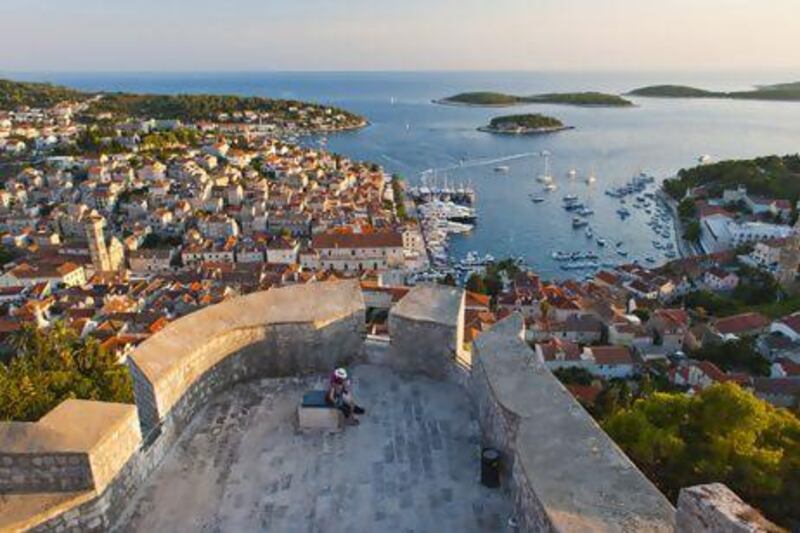The plan is simple: to bridge the stretch of Adriatic Sea for a summer holiday in two countries in the space of a week. It would start with a road trip through Italy's Abruzzo and Le Marche before sailing across that ink-blue gap of sea and into Croatia. Typically, the weather would have other plans. "We cannot sail," the skipper tells me gravely. Despite plans for our private charter falling flat, I feel calm. For while the masses drive on towards Rome, my travel companions and I veer off to rural L'Aquila, stopping in the medieval village of Calascio.
When I take the skipper's phone-call, I'm staring across a tapestry of apple-green hills, sparsely punctuated by farms and stone villages, while to the west sit the Apennine mountains. I tear myself away from the view to join my friends at a long table, belonging to Rifugio Della Rocca restaurant, where the obliging manager happily sets up for us outside in the sun, in the middle of a narrow, cobbled street. In this village, a group of tourists being sat in the middle of a road is of little interest to the locals - just two families live here. And two dogs.
In Abruzzo, our guide tells me, uninhabited protected areas and historical villages are commonplace. One third of its territory is set aside as national parks and protected nature reserves. It's one of the greenest parts of the country but is often overlooked for better-known, more westerly regions such as Tuscany.
After a spread of homegrown, home-cooked fare - wild meats with lentils and sunblush tomatoes, fresh pasta with mushrooms and pecorino cheese - a calorie-burning hike takes us to the village's main draw: Rocca Calascio. At an elevation of 1,460 metres, it's one of the region's most majestic castles, set above the breathtaking plains of Navelli.
Santo Stefano di Sessanio - our next stop, a 30km drive away - would be deserted were it not for one man: Daniele Kihlgren. By a hand-painted hotel sign - Sextantio - we find the rugged Sicilian straddling a motorbike. In 1999, he chanced upon the decaying mountain village while lost. Back then, it was home to 60 people. In its 15th-century heyday, though, 3,000 residents thrived from the Medici wool trade. Post-industrial decline and the effects of the Second World War saw it empty out, like so many of the region's villages, as people left to seek a better life abroad. Kihlgren bought the hotel to "revive its peasant heritage" and, now restored, visitors can spend the night living as would-be villagers.
Inside my room, the ceiling is low, curved and cave-like; the walls are unpainted and blackened and creature comforts come in the form of underfloor heating and a huge, freestanding tub. Each of my friends' rooms differs - from sloping beams to duplex digs and authentic details (one has metal rings hanging above the bed - a former stall).
While Abruzzo is full of historical villages, neighbouring Le Marche is rich in ancient art towns (few realise, but it has the greatest density of museums and picture galleries in all of Italy) and none more so than our next stop, Ascoli Piceno.
As Marche's major centre, Ascoli buzzes with life - from the morning fruit market beneath the St Francis Church cloisters to the locals who mingle in the main square, Piazza del Popolo. Called the "city of travertine", most of its buildings are made from a handsome, ivory-hued limestone, extracted from the surrounding mountains.
Art buffs will find its trio of art museums impressive, and an €8 (Dh38) pass grants you access to all. Even the square's pastel-pink-painted Cafè Meletti exhibits historic art - and as one of Italy's oldest cafes (and former watering hole of Ernest Hemingway), I can't resist an espresso break beneath its Art Nouveau arches.
Back on the road, I'm excited by our next endeavour - a stay in one of this region's age-old guesthouses. Namely, the 18th-century Borgo Storico Seghetti Panichi, a property that's been transformed into a grandiose country house hotel by the heiress, Giulia Panichi Pignatelli.
It's pretty as a picture: honey brick with grass-green shutters; we reach it at the end of a winding gravel driveway. Inside, it feels like a private family residence with individual suites (mine, Cielo, is elegant and painted a duck-egg blue). Its gardens are just as cherished: planted between 1875 and 1890 by the German botanist Ludwig Winter, its rare blooms and trees now form 30 bioenergetic areas, a first for Europe, and attract special tours.
Our next stop entails an overnight ferry trip: the best way, we decide, to reach Croatia safely on a stormy night. Alternatively, you can arrange chic private yachts and crew via Borgo Storico Seghetti Panichi.
We leave from Ancona at 8.15pm for Split, and the ferry's sheer size means I manage to ride the storm and get a decent night's sleep in a matrimonial suite (the best digs on board) before arriving on Croatian shores at 7am, where we promptly hop aboard a catamaran to Split and drive on to our base: Hvar.
A decade ago, few had heard of Hvar, but celebrities have now cottoned on to its Adriatic allure: Beyoncé has holidayed here (according to a guide, it's where she first saw a flower named Blue Ivy), Valentino sailed in (only to sail out at the sight of paparazzi) and Prince Harry was photographed diving, fully-clothed, into a hotel pool.
With a paved piazza, yachts and fishing boats bobbing on a pretty harbour, and a palm-lined promenade, Hvar has glossy good looks. In contrast to the Old Town's medieval stone buildings, chic waterside restaurants (see Gariful for first-rate fish) and smart hotels now line the promenade - which is where we check in to Rvar, Hvar Yacht Harbour Hotel. Modern, pristine and playful with red Perspex finishes and monochrome prints of 1940s stars (in my room, Veronica Lake), it places us in Hvar's social heart.
It would be all too easy to succumb. But, just as in Italy, there are overlooked villages just waiting in the hilltops - a perfect way to escape the crowds. On a scenic drive to Stari Grad, which sees us cruise high above wavy coastlines, we see some: Malo Grablje (zero residents), Zarace (three), Velo Grablje (four residents and home to the Festival of Lavender) and Selca (a solid 40).
Stari Grad is one of Europe's oldest towns, founded by the ancient Greeks in BC384. Despite such a claim to fame, we are virtually alone when we step out onto its serene streets and meander by its idyllic harbour. It's a place to wander, rather than tick off tourist sites, so we while away idle hours in its winding stone alleyways, punctuated by yellow, blue and green shutters, and stop off at quaint shops and street cafes for Dalmatian nibbles (try the salt-cured fish and meat).
But there is another way to bypass Hvar's droves of pleasure-seekers. A taxi boat whisks us to Palenki Otoci - an archipelago of 16 untapped islets - the largest of which, Sveti Klement, is home to Palmižana. We wander in to the bohemian sanctuary, strewn with lush fauna and bold blooms while, through the palms, cacti and birds of paradise, I spy pebbled shores and baby-blue bays. Originally founded in 1906 by Professor Eugen Meneghello, he turned the land into a botanical garden and, three generations later, Palmižana's now in the artistic hands of Dagmar Meneghello, who has introduced a gallery of Croatian artworks, plus seven stone villas and six bungalows.
Indeed, even if you don't stay here, it's well worth the short boat ride from Hvar to dine on its colourful restaurant terrace, and it's here I try Hvarska gregada, a superb Dalmatian casserole that is swimming with lobster, potatoes and shellfish in a cauldron-like pot.
Forgotten villages, cultural heritage, idyllic islets, offbeat abodes and authentic fare - in the space of one week I had sampled it all, traversed the rural and coastal domains of the Adriatic Sea and crossed over borders too. As I leave Palmižana by boat, the clouds are dark grey and heavy with rain. But don't let the prospect of a little wet weather put you off.
IF YOU GO
The flights Direct return flights from Abu Dhabi to Rome with Etihad (www.etihad.ae) cost from Dh3,295 return including taxes. The flight takes seven hours. A one-way flight from Split to Rome takes one hour, from US$42 (Dh154) with easyJet (www.easyjet.com)
The ferry An overnight ferry on Snav (www.snav.it) from Ancona to Split costs from $118 (Dh429) incl taxes
The hotels Double rooms at Sextantio (www.sextantio.it; 00 39 0862 899 112) cost from US$264 (Dh1,000) per night with breakfast and taxes. Double rooms at Borgo Storico Seghetti Panichi (www.seghettipanichi.it; 00 39 0736 812 552) cost from $264 (Dh1,000) per room, per night with breakfast and taxes. Double rooms at the Hvar Yacht Harbour Hotel (www.suncanihvar.com; 00 385 21 750 100) cost from $171 (Dh622) per room, per night, with breakfast and taxes, and self catering bungalows at Palmižana (www.palmizana.hr; 00 385 21 717 27) cost from $105 (Dh382) per night including taxes
Follow us
[ @LifeNationalUAE ]
Follow us on Facebook for discussions, entertainment, reviews, wellness and news.





